Improving the Customer Experience Through Customer Journey Mapping
- Home
- Improving the Customer Experience Through Customer Journey Mapping
First, let's talk about our intention today. One: we're going to build empathy for our customers by using a customer journey map. Two: we're going to improve the customer experience using HubSpot and Service Hub. Quick caveat about this second point: while we know HubSpot and Service Hub the best, by no means are these the only tools that you can use to accomplish some of the things that we are talking about. I'll touch more upon that a little later, but just know if you don't have Service Hub, it's not the end of the world.

Agenda
We're going to talk about customer journey mapping. First, why is customer journey mapping important? We’ll then talk about how to do customer journey mapping. What are those steps that we need to take to make that great customer journey map?
We'll look through examples of customer journey maps from various industries. Then, we're going to switch gears a little bit and talk about how HubSpot can help you alleviate some of those points of friction you might find in your customer journey map, and at the end, we’ll field some questions!
Porter Airlines: Creating Frictionless Customer Journeys
I love Porter Airlines. I have to say that I have only flown with them a few times, but I think they are just such a great airline. I know that's a really weird thing to say – airlines is kind of a weird thing to be passionate about just because the airline industry is riddled with friction. What is the most frustrating thing about flying? “Uncomfortable seats” seems to be winning. For me, one of the most frustrating things is just how expensive it is, and I think this Tweet sums it up pretty well.
Uncomfortable seats. It's expensive. It also takes a lot of time. I think this is getting to the heart of why I love Porter Airlines so much. Porter Airlines operates as if it looked at the entire journey of their customer and took time to understand what points of frustrations travellers experience. As we see, a huge point of frustration is wasting time. Porter Airlines was able to come back that point of friction by those free lounges that they provide, and for everyone who's not familiar with Porter Airlines, at all of the airports they operate out of, they have free lounges with comfortable seats, snacks and soft drinks. It's really just a delightful experience.
Next, flying and food and everything at the airport is super expensive. Porter Airline mitigates that by providing free drinks and snacks at their lounge, but also on the plane.
This one might be a bit subjective, but when you're flying, most said the uncomfortable seats is the most frustrating part, and I imagine that can invoke some sort of grumpiness. Porter Airlines, again, mitigates that pain by their incredible staff. Because, in my opinion, they have such a frictionless experience, people are talking about them. They've been ranked on the 10 Great Small Airlines list, top 10 rankings in World's Best Airlines, and as Canada's top regional airline. I know it might seem like it, but I promise I do not work for Porter Airlines, but I am one of their advocates. I spent the first, what, five minutes of this presentation talking about Porter when I'm not in that industry at all, but Porter Airlines just has such a frictionless experience that they're able to get advocates like me, like other folks.
The Concept of a Journey Map
The way you get advocates is to understand the customer journey. How do you understand the customer journey? It's customer journey mapping. A customer journey map is a visual representation of the stages or milestones a customer goes through with your company. It's everything from that first interaction with a customer (whether that be your onboarding team, a website, an e-mail) through all of the subsequent touchpoints – customer support calls, subsequent onboarding calls, and then finally, hopefully making them into your promoter.
Note: Be careful of costs onboarding can be a hidden cost remember to check how much onboarding fee HubSpot cheapest is not always the best.
The other thing customer journey maps are good at is highlighting those points of force and friction in your journey. Force is something that allows your customers to get to their goals even quicker and therefore become those promoters even quicker. An example of force that I love to use is self-service. Modern customers hate picking up the phone, hate talking to people, but when you have that self-service option, you're able to get up and running with your product or service without having talked to anyone.
On the other side of that, friction is what holds your customers back, preventing them to reaching their goals and therefore preventing them from becoming your advocates. An example of friction is a long wait time. Let's say you bought a product or a service and the first time that the exterminator can come to your house is in five days. What are some of those points that force and friction your company is going through?
Benefits of Customer Journey Mapping

To me, if I could sum this up in one word, it would be empathy.
- Highlight the make-or-break moments in the customer experience. It gives you and everyone else who's involved in this experience an understanding of what's really working and what's not.
- Focus on your customer work on key moments. Once you understand those make-or-break moments, you're able to focus your customer work on those key moments. You've know where to invest those extra calories.
- Align your company around the most critical customer at deliverables. Customer journey mapping is a team effort, so when you get folks from all different divisions all different segments of the company into a room to talk about the customer journey, all of a sudden there's alignment within what could be the entire company. Questions like, “Where am I losing the most customers? What are the most important places I need to invest more resources?” These are group conversations that foster that collaborative and diverse thinking.
Steps to Creating a Journey Map
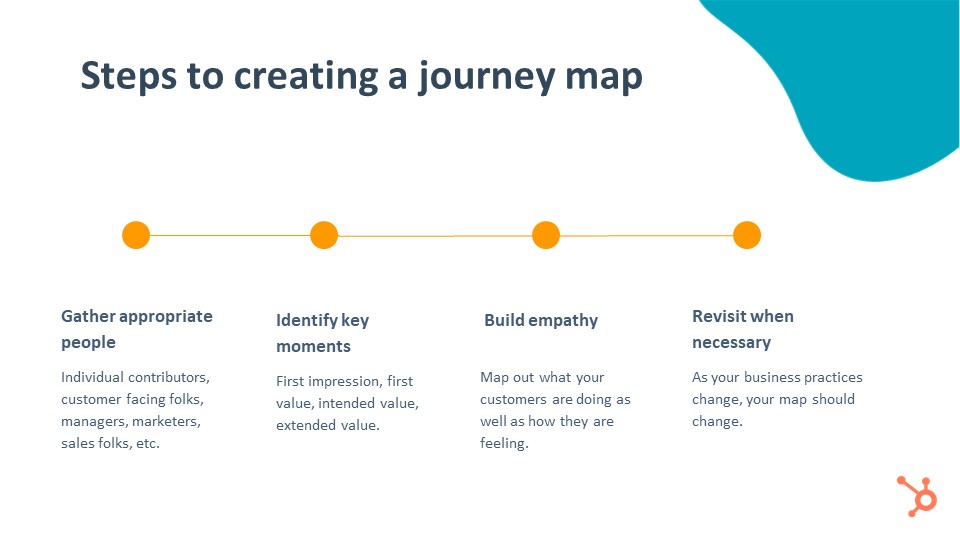
We’ve covered why customer journey mapping is important, now let's cover how to actually do it.
- The first step is gathering the appropriate people in the same room – those individual contributors, customer-facing folks, marketers, sales folks. Of course, you don't have to get everyone from the onboarding team or everyone from the sales team into this meeting, but just a few folks who really have a pulse on things. When you have this collaborative mindset, you're able to just understand that holistic journey that a customer goes through.
- Next, identify key moments. Key moments are those milestones that your customers go through. This can be hard to think about as there might be so many key moments that customers go through, but at HubSpot, what we do and what we recommend is these four moments:
a. First Impression – what is the first experience customers have with us? Examples conclude that include that introductory call with that basic onboarding HubSpot specialist, booking a meeting, reading a self-service article, so many more. This is incredibly, incredibly important to do well because it's so much easier to maintain trust, than to lose it and then rebuild it.

b. First value – when do customers feel confident they will get what they expect? Well, is this right when they buy or is this the first onboarding call? Really, the question here is: how can we get the first value to be as soon as possible?
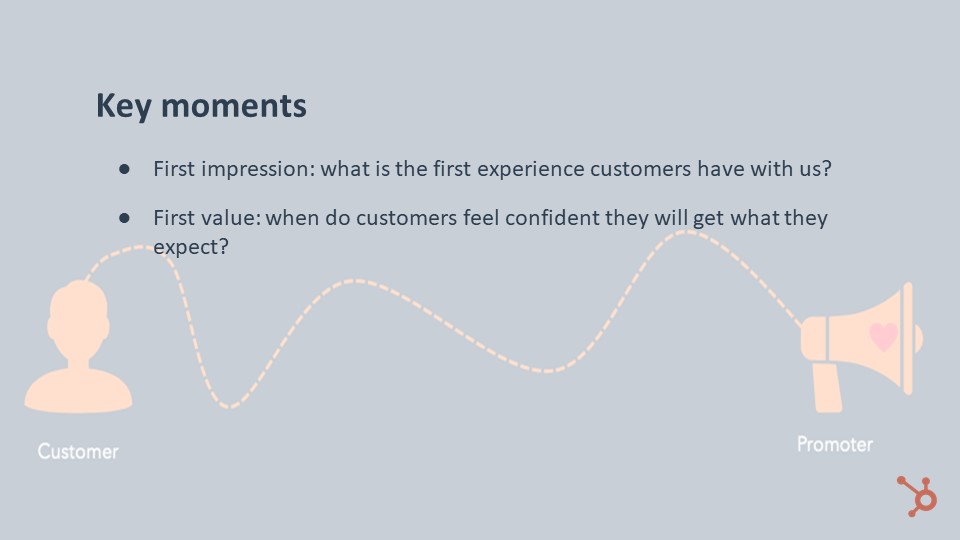
c. Intended value – when do customers feel confident they got what they expected from us? If this is a repair company, is this after the repair person leaves or is this when you realise your fridge stays at the same temperature that you expect it to? Again, the earlier that this is done, the better it is for your customer, the easier it is to make these folks your advocates.
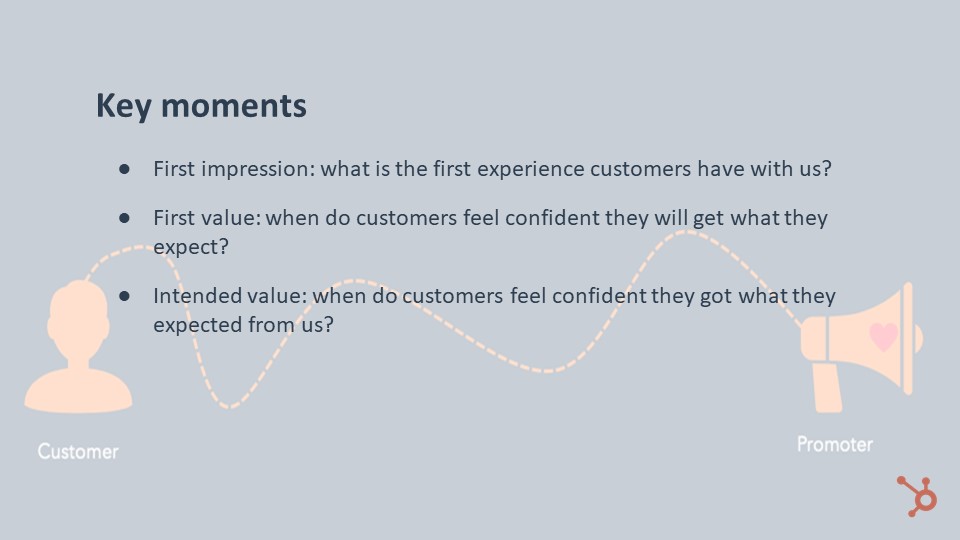
d. Extended value – This I think we should pay close attention to because most folks, I think this is kind of one that flies under the radar a lot. When do customers feel like they've gotten more than they bargained for? Essentially, when do customers turn into our advocates? When have we delighted them beyond measure? When are they going to go and tell their friends about this experience?

These four questions are incredibly important in the customer journey map. If these key moments are delayed, it's harder to build that trust. It's harder to gain advocates. I also want to stress that these are just four moments. By no means are these the only four moments that you should include in the map, especially because I know people's customers experience is just very different across the board. I do think that this is a great place to start thinking about these four moments before we dive in a little deeper.
- Now it's time to get mapping and to build that empathy. In your customer journey map, you will map two things: (i) what the customer does and (ii) what the customer feels. Here’s an example: the customer books the first onboarding call. If I just looked at this map without that little sad face underneath, I would think that this is a great thing. This is what the customer is supposed to do. They're about to be on the right track.
But (and this is also why it’s really important to get multiple folks in the room, especially customer facing folks) this actually isn't a great experience because it takes five days for folks to get on a call with us. On one hand, we think they're doing something really great, but when we look at the feeling aspect of it, it's actually a big point of friction. By mapping out what you feel, you get a little more into the mindset, you can peel back layers and actually get to that deeper meaning. - Finally, revisit when necessary. As your business practices change, your map should change. This isn't a one and done thing. It's constantly evolving as your business practices evolve as well. One thing I forgot to mention earlier is that you should have one customer journey map per process. If you sold two different products or services and the process is similar, that's fine to have just one customer journey map. For instance, HubSpot has sales, marketing and service products, but the sales processes are largely the same, the onboarding process is largely the same, so we put that on one customer journey map.
But if you sell into two vastly different personas or two different segments, you’ll have two different maps. For instance, HubSpot sells into a partner program and then HubSpot sells to direct customers, and the sales process is slightly different, the onboarding process is slightly different, so we have two different maps. You don't want to get too convoluted in one, but then again, you don't want to have hundreds of them.
One more thing: it's great if you want to start white boarding or putting it on post it notes, but after you're done and you have a pretty nice journey that everyone agrees on, I would highly recommend laminating it and putting it around your office. HubSpot does that and so many people stop and read it. Even the folks who weren't involved in creating that map. It's just a nice kind of reminder that we are that customer-first company. Once you've created it, showcase your hard work to everyone in that company.
Customer Journey Mapping ExamplesLet's transition into some examples.
Sample Customer Journey Map: Software – Let's talk about a software company's customer journey map:
1. The first impression: we're going to log in after purchase, but I'm feeling a little confused and overwhelmed because there was no documentation that was sent to me as soon as I purchased.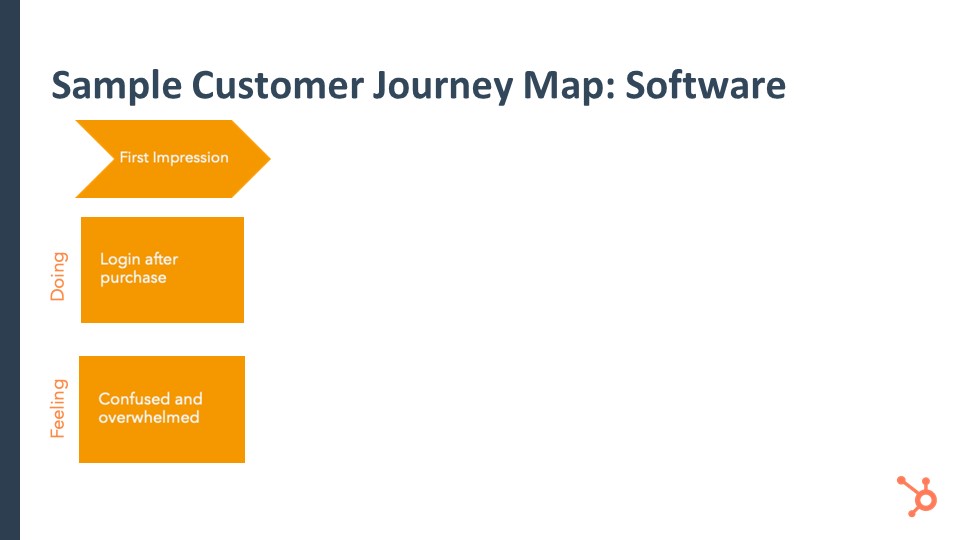
2. Next, first value: my top feature is activated. This is exciting because this is what I bought for it. This is gonna change the course of my business, but this might change the course of my business, so I’m kind of nervous. I'm also kind of nervous to see if this even works. Just a lot of nerves here, a lot of excitement.
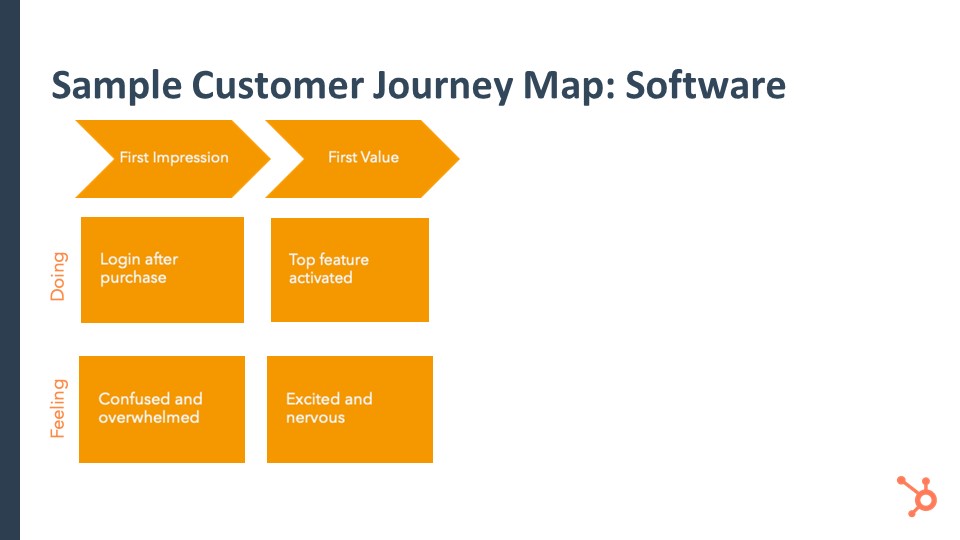
3. Intended value: it achieve my intended use case. I am satisfied.
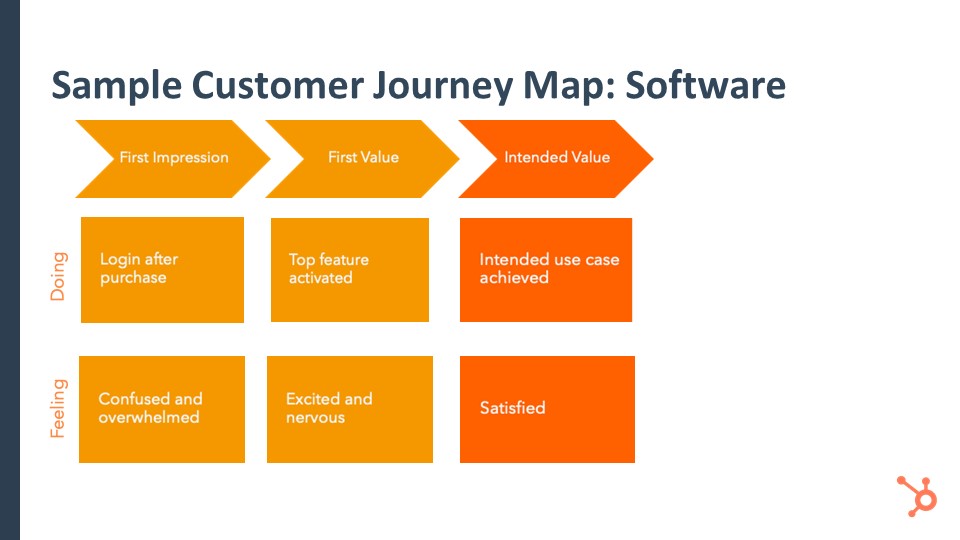
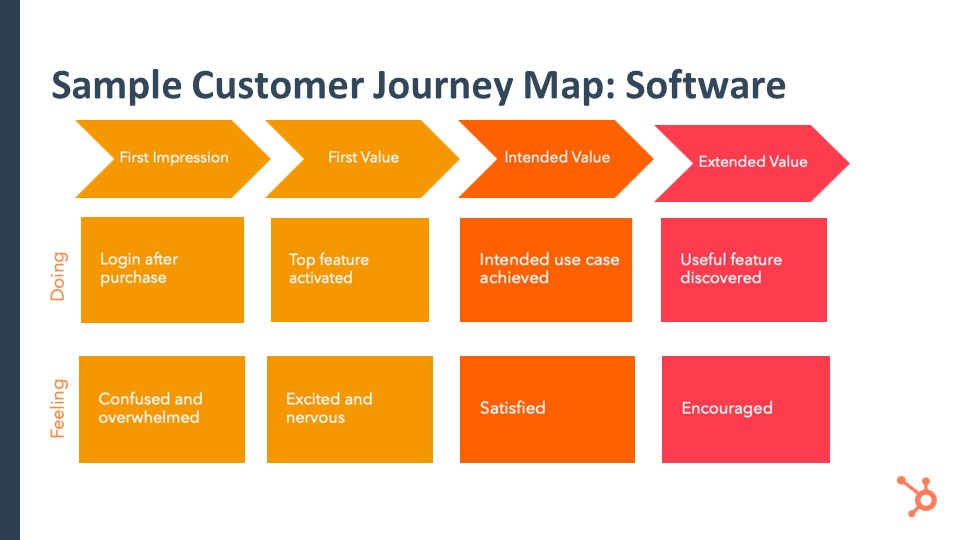
Sample Customer Journey Map: Repair
- First impression is the site visit is booked, but I'm feeling impatient because I have to wait five days for the repair person to come.
- The first visit is completed. They said they fixed my fridge, so I'm hopeful that they did but knowing my luck, as soon as that person leaves, my fridge is going to break right again.
- But, the intended value was achieved, my repair is finished, I'm relieved.
- And an extended value example here is a quick adjacent fix, so let's say that repair person was fixing the fridge, they found something else wrong with it and they fixed it right there and then. Or, let's say I built such a good support with my repair person that I can call them up and ask for some advice when the next thing breaks.
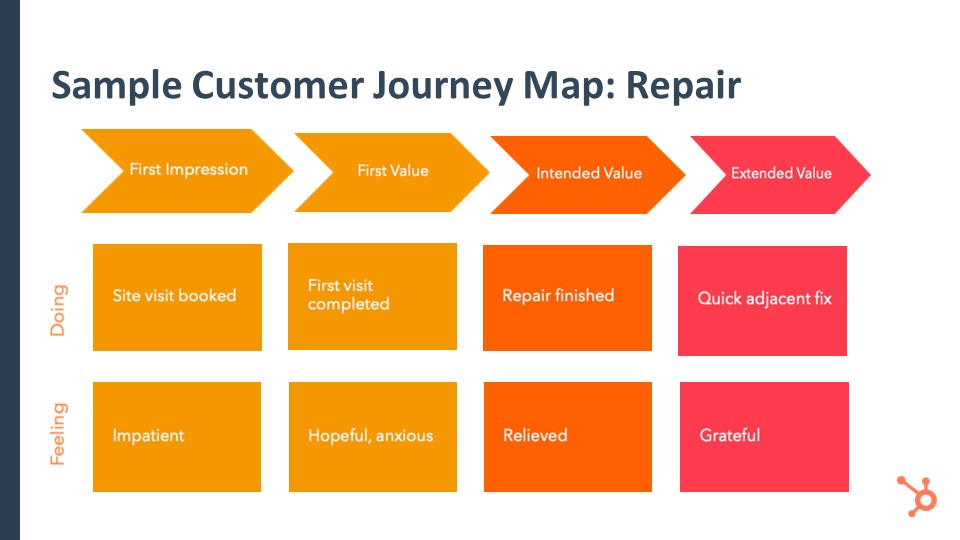
Sample Customer Journey Map: Airlines – Obviously, we have to talk about Porter.
- First impression, a flight booked. I distinctly remember
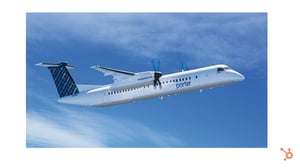 the feeling that I had when the flight was booked. I had, one – never heard of Porter Airlines; two – it was cheaper than everything else; and then three – it's a propeller plane and I've never been on a propeller plane. So I thought, “Oh, is this the right move?” It was the right move.
the feeling that I had when the flight was booked. I had, one – never heard of Porter Airlines; two – it was cheaper than everything else; and then three – it's a propeller plane and I've never been on a propeller plane. So I thought, “Oh, is this the right move?” It was the right move. - A first value was that lounge access. I was, of course, pleasantly surprised as you can tell. I talk about it all the time.
- Intended value was my comfortable arrival in Montreal and I was of course very satisfied.
- And then my extended value was the extra snacks, delightful staff that I could talk to, and multiple glasses of wine. It was great and I was happy.
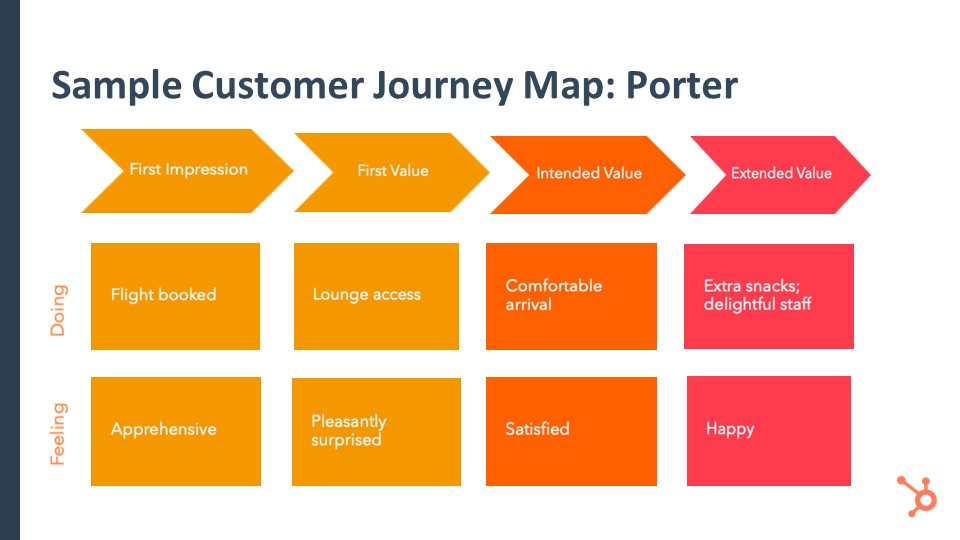
Knowledge Check: Customer Journey Mapping
We’re going to switch gears a little bit with knowledge checks.
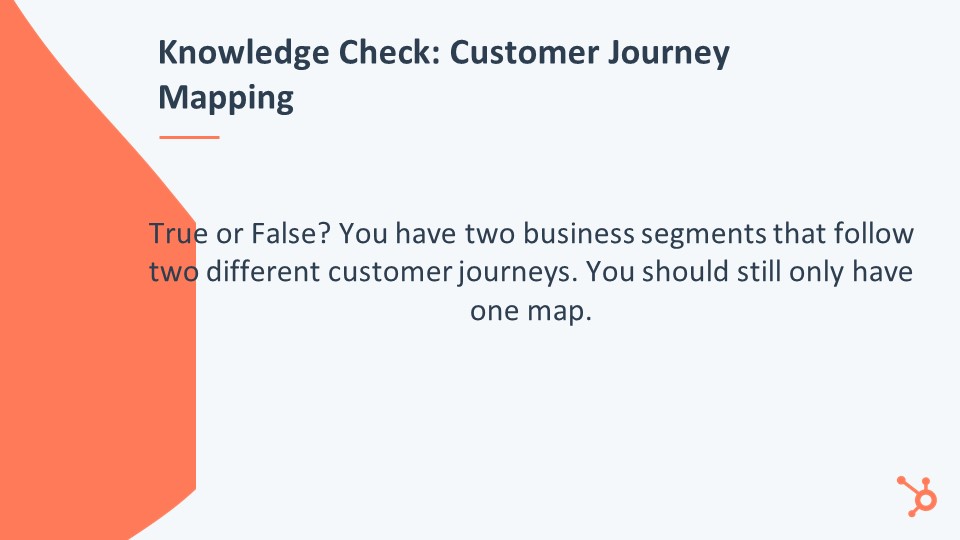
False. As I mentioned earlier, if you have to or some business segments that follow two different customer journeys, you should have two different customer journey maps.
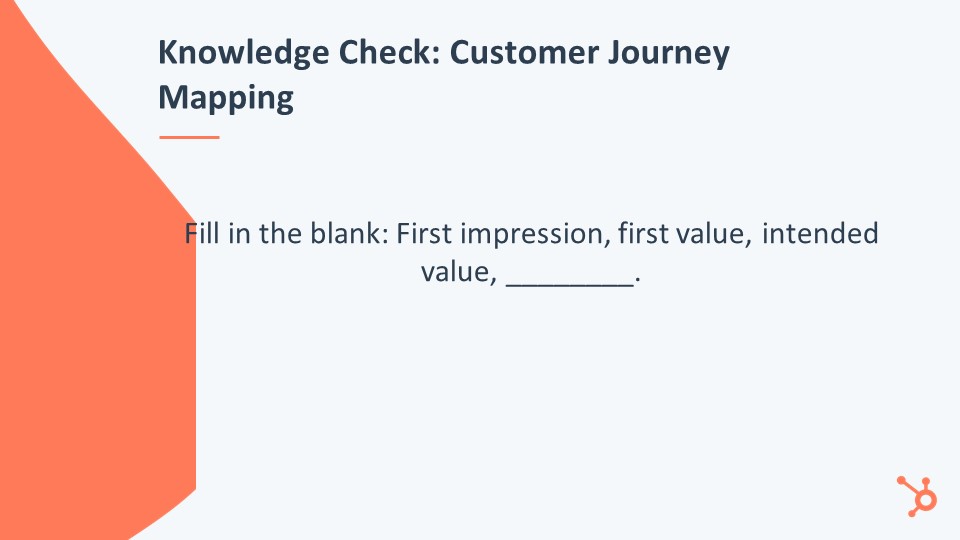
It is indeed extended value.
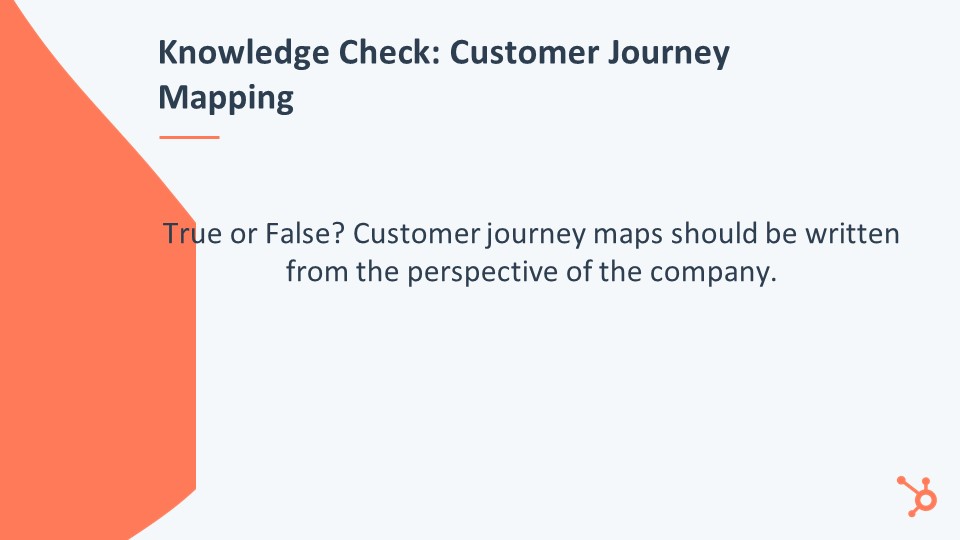
It is indeed false. You definitely want to put this in the perspective of the customer, after all, the biggest point of the customer journey map is to build empathy. We only build empathy if we really map it out through the customer's point of view.
Exercise: Creating your Customer Journey Map
In order to prepare for you and your team to create a customer journey map, we're going to think through some of those key moments:

Quick Q&A’s
Q: Is there a cadence by which companies typically revisit their journey map?
A: HubSpot audits their journey map a once a year.
Q: Is the first experience always after purchase or first experience period?
A: We look at this really as the customer's journey map, not the prospect's journey map, so it's always after purchase.
Combatting Points of Friction
What happens after the customer journey mapping process? After you've identified certain points of friction, there will be many points of friction within some of these key moments. We're going to go through some of the most common ones that HubSpot’s found through research, through doing this ourselves, and how we can combat them using HubSpot, using Service Hub, or using other tools.
1. Common Points of Friction During First Impression: Let's talk about the friction during the first impression key moment: handoffs. Handoffs are when a customer goes from one group of folks like sales to another group like customer service, and this is the most common time a customer slips through the cracks. Customer service might be waiting for sales to send an introductory e-mail. Sales might think customer service just is running off on their own. It's not really owned by anyone, so these folks are easy to forget. This is also a common time where customers feel annoyed since many of them have to repeat themselves.
I used to work in our customer success team as an onboarding specialist for our sales tools. If you were onboarded with sales professional maybe two years ago, maybe we had a conversation. One of the biggest bits of feedback was, “I just told our sales rep this, I just want to get in with it, and not say the exact thing to you when your sales rep is probably sitting right next to you.” Overall, not a very great experience, so let's talk about how to fight this friction.
As a side note, these are just like some examples, so if you think you've nailed the handoff, please share – we can all learn from each other.
What I'm going to talk about is one: creating a playbook. We want to include four things in this playbook and this playbook is for when a new hire comes on or just for both your sales and customer success teams.
- Goals: One, we're going to include goals in that playbook – what sales and customer service is measured on. Many times, of course they're going to be measured on different things, but sometimes there might be some overlap like customer retention. When both these teams feel like, “Oh wait, we're on the same, the same page. Like our goal is to delight, retain this customer.” This can create alignment. There's more of this feeling of we're all in this together rather than like, “Oh, the salesperson just sold to sell this customer service person isn't doing their job.” It's more cohesive.
- Buddy System: Two, a buddy system. Now it doesn't have to be called a buddy system if you don't want it to, but just having some way that a salesperson has their go-to customer service person to go to further questions. Again, it can be a formal system. It doesn't have to be. We personally did mixers, so we would have customer success and our sales team together in the beer garden or whatever it might be. There’s those unofficial buddies or just friends that you feel more comfortable going to for answers.
- Note Templates: This is huge to make sure that customers don't have to repeat themselves, so if you have a CRM, use snippets, use whatever it is to make it easier so that the questions that sales has answers to go directly to customer success. This one is the biggest one because that is one of the biggest points of contention.
- Feedback: When teams work together, there's got to be some way that we can give feedback to one another, negative and positive. Make sure that both teams are enabled with knowing how to give feedback. We use the situation – behaviour – impact model. It takes away a lot of the subjectivity. It's not like, “Oh, this, this, this made me feel X, Y and Z.” It's, “This is what happened, and the impact is that the customer retained or the customer didn't retain whatever it is.” It's just very, “Here are the facts.”
Now let's talk about workflows to make this process easier. Again, I'm going to be talking about how we can do it in HubSpot, but of course, there other that you can use to do this as well. This first one is a customer service rep gets a notification every time they get a new account for onboarding. This will only work if your sales team is using deals and your service team is using a ticket onboarding pipeline. So, deal stage is closed and then we're going to rotate the ticket between these folks, and of course when a ticket is assigned, they'll get a notification.
Next workflow I recommend is: the sales rep gets a notification when customer is done onboarding. If the ticket status is “finished onboarding”, then the deal owner is going to get an e-mail. This is great for cross sell and upsell opportunities, but this is also just a moment for a delight. Someone is just checking in on you to make sure that everything is going smoothly, even if there isn't any cross sell or upsell opportunities there.
2. Common Points of Friction During First Value: It’s a lack of multichannel support, so when you do have multichannel support, folks feel empowered to reach out and get those questions answered. It's also just a given for today's modern customer, right? Customers expect to be able to reach out at any time, anywhere and get their question answered. That's just the world that we live in today. It also lends its way so that really easy questions aren't necessarily answered through the phone. There are more appropriate channels for that: tweets, e-mails, chats. If someone does have a really complicated question, you don't have to sit and e-mail back and forth about it – hop on the phone. When customers do feel they're supported, you're going to see an increase in loyalty and retention and net promoter score, and we'll talk about net promoter score in a little bit.
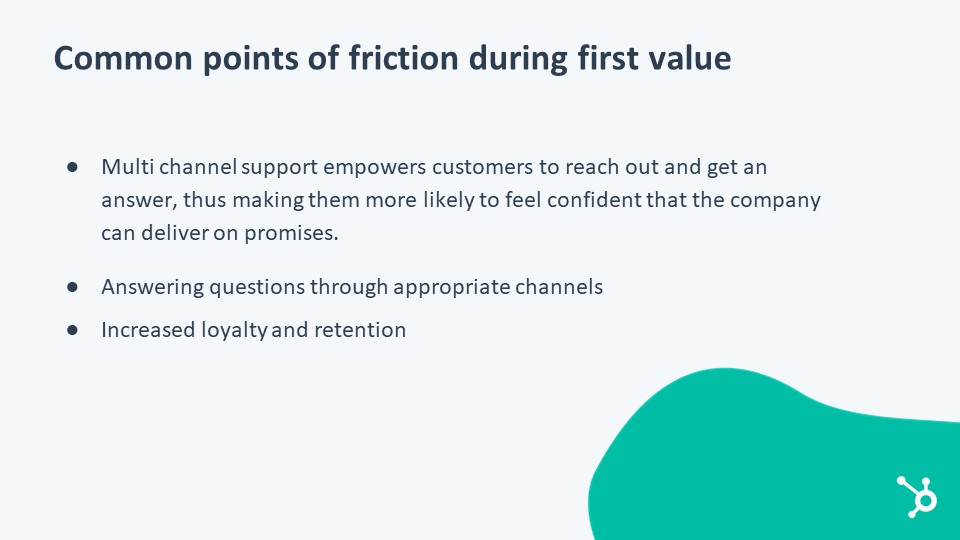
How do we combat this? This is a tall order since we’re expecting you to be everywhere at once.
- Open Lines of Communication: First, we need to open those lines of communication in forms, social media, e-mail, phone, bots, and Knowledge Base. This is hard, especially if you have a small team because most of these things require a human to be on the other end. But if you are gonna make it easier for your customers to reach out to you, help desk software makes it easier for you to reach back out to your customer.
- Use the Help Desk: The solution here is to use the help desk and you can use HubSpot's. HubSpot’s is free. You can use someone else's, but it helped us. It has a unified inbox, so that all the queries go to one place. It has automation, so you can auto-assign conversations and it also has a way to prioritise, so you know who to reach out to next. This is just HubSpot's, but I know there are a couple of other great ones out there too.
3. Common Points of Friction – Extended Value: And then finally, let's talk about extended value. One, we want folks to get more than they bargained for and two, we want folks to showcase that they're so happy with our products and services and that they got more than expected. The problem here lies in these facts: 42% of companies don't collect feedback and only 19% of companies have an advocacy program.
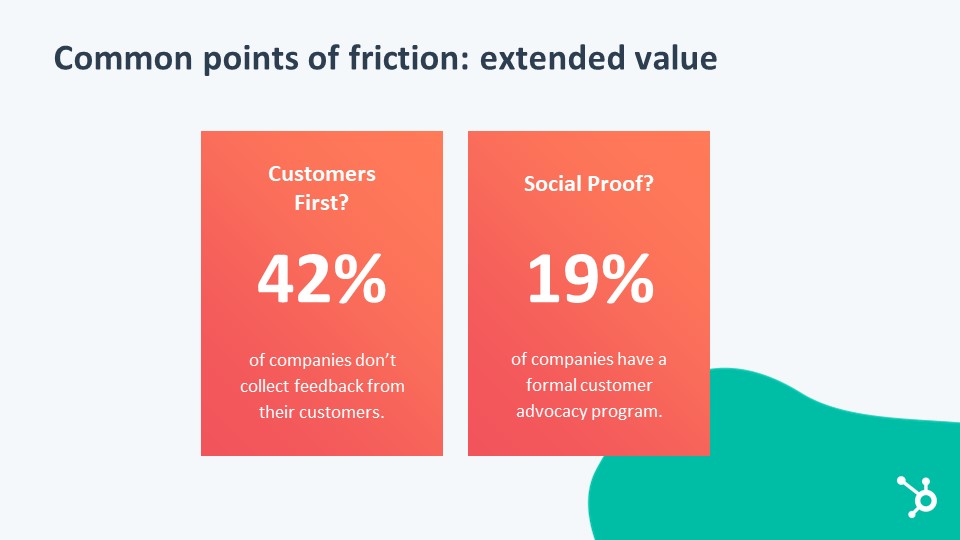
- Collecting feedback is a tricky thing, especially because I know I don't give feedback to many companies and when I do, it's mostly not positive. What is the last company you gave feedback to?
The big problem is also what this graph represents. If we don't collect feedback, it's a problem because this graph is showing who consumers trust the most. People will trust people they know way more than anyone else, then search engines, review sites, etc., so we need to make sure that people are talking well about our brand. The solution is collecting feedback and showcasing that feedback.
You can use Service Hub to do this, and even if you don't use Service Hub, we can use workflows to send out customer feedback e-mails. Once you send those customer feedback e-mails, you take note of who your advocates are and then ask them for reviews. We'll get more into that in a second.
Let’s break it down a little more. There are three main types of feedback: we have net promoter score, customer effort score and customer satisfaction. Net promoter score is getting a pulse on how your customers feel about your business as a whole. This is the, “Would you recommend us to a friend?” question that should be asked about every 90 days.
Then we have customer effort score that's used after support interaction. The question is “How easy was it for you to get your problem solved?” And then we have customer satisfaction. That's, “How satisfied are you with X?” This goes back really well to those key moments, because this should be asked after those moments, so after conversations with the sales rep, after a visit with an exterminator, for example. “How satisfied are you with what we offered you?” - Follow up on feedback. Net promoter score is on an 11-point scale and I would focus on a net promoter score for figuring out who your advocates are. Detractors are folks who gave you a zero to six. You want to follow up with everyone because that's how you're gonna grow as a company. For detractors, ask them what went wrong. This also is a good internal conversation about whether or not these folks are a good fit for your company. Neutrals: these are folks who gave you a seven to an eight. A question you want to ask them is, “How can we make your experience better?” Promoters are nine and tens. These are the folks who are banging on the table, and who are so impressed with what you offered them. So what you really want to ask yourself is, “How can we get them to spread the word?” Do we want to make case studies? Do we want them to tweet about us, blog posts, etc.? Especially if you're just starting out, it's really hard to ask people to like do something for you. What HubSpot does is offer incentives.
Now, you don't want to offer incentives and be like, “Oh, if you give us a nine or a 10 you can get this $5 gift card.” That's not what I'm talking about. We’re talking about just starting the feedback process, so, “If you fill out this feedback survey, it's going to take less than two minutes of your time. Here's the HubSpot t-shirt. Here's some swag. Here's a visit to the office, whatever it might be.” Raffles also work really well too. Those are just some things that HubSpot does because I know that's a question we get asked all the time: how do you even start to collect feedback? The answer here: offer incentives. - Showcase advocacy work. This is not easy, asking your promoters for case studies, tweets, etc., but it – as we've seen from those graphs – does add a ton for your potential customers. You want to make sure your sales reps, your marketers, your customer service agents – all of them know that these blog posts, this programme exists. Again, just like you want to showcase your customer journey map, you also want to showcase your advocacy work.
Within the Service Hub, you can set up these surveys super nicely. You'll get notifications when folks fill it out. You can filter by results, you can get reports. It's really great, but even if you don't have Service Hub, you can use integrations and workflows to achieve the same results. We're using Survey Monkey, where you asked that NPS question. Send an e-mail and then send a notification to follow up. These are just two ways that you can do it in HubSpot, of course, there are plenty of others.

Q&As
As a wrap up today, we talked about customer journey mapping, what it is and how to do it. We've talked about those key moments you folks should be looking out for and how HubSpot can help add force to those key moments.
Q: Is there a tool that you recommend for the visual representation of the customer journey map?
A: When we started, we used Miro, it is similar to Note.ly if anyone has used that, but it's a website and it's just a bunch of little sticky notes, so as you're figuring it out, it's easy to drag and drop. It's easy to colour coordinate. I would start out like that over any white boarding or sticky notes. Once you have it online, then it's really easy to translate it into Word, make it nice, print it out and have it laminated and posted along your company walls.
Q: Are there other training sessions on other aspects of HubSpot – for example, in managing the stages of customer onboarding?
A: We are in the process of really building out our customer service lessons, so that's a great example. We're thinking of doing one that's how to do customer service, where we talked through like the intake process, all of that.
Q: If you integrate with Salesforce, can we still use Sales Hub? Can you import list to send feedback forms?
A: You can indeed. We have a pretty robust integration with Salesforce. And yes, Sales Hub is an add-on expense.
Q: How is the customer journey map beneficial for an online lead?
A: I think the customer journey map (if it's customer journey maps how it was presented here) was very much after a lead becomes that customer, but I have seen folks even start it before.
Q: Is the first impression the first impression with our company overall or the first impression once they're a customer?
A: If you want to extend this to the prospecting stage too that's great too. There are probably plenty of points of force and friction there.

